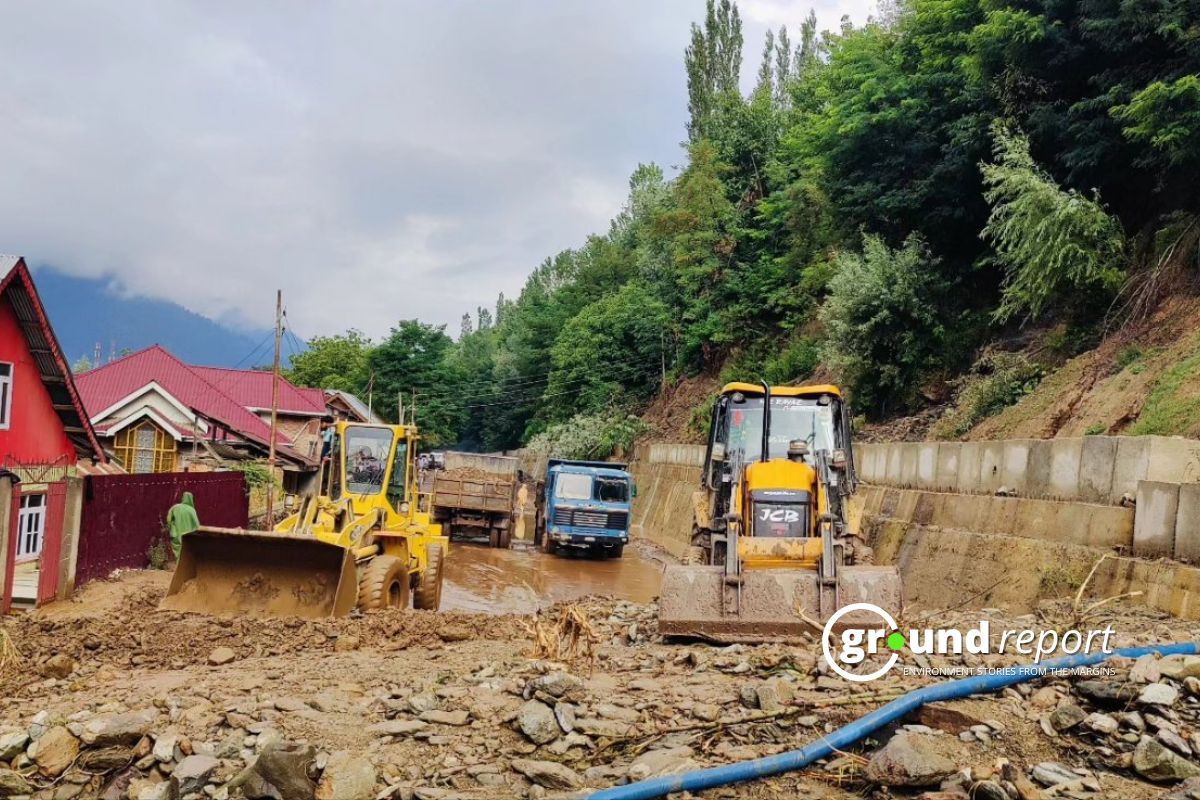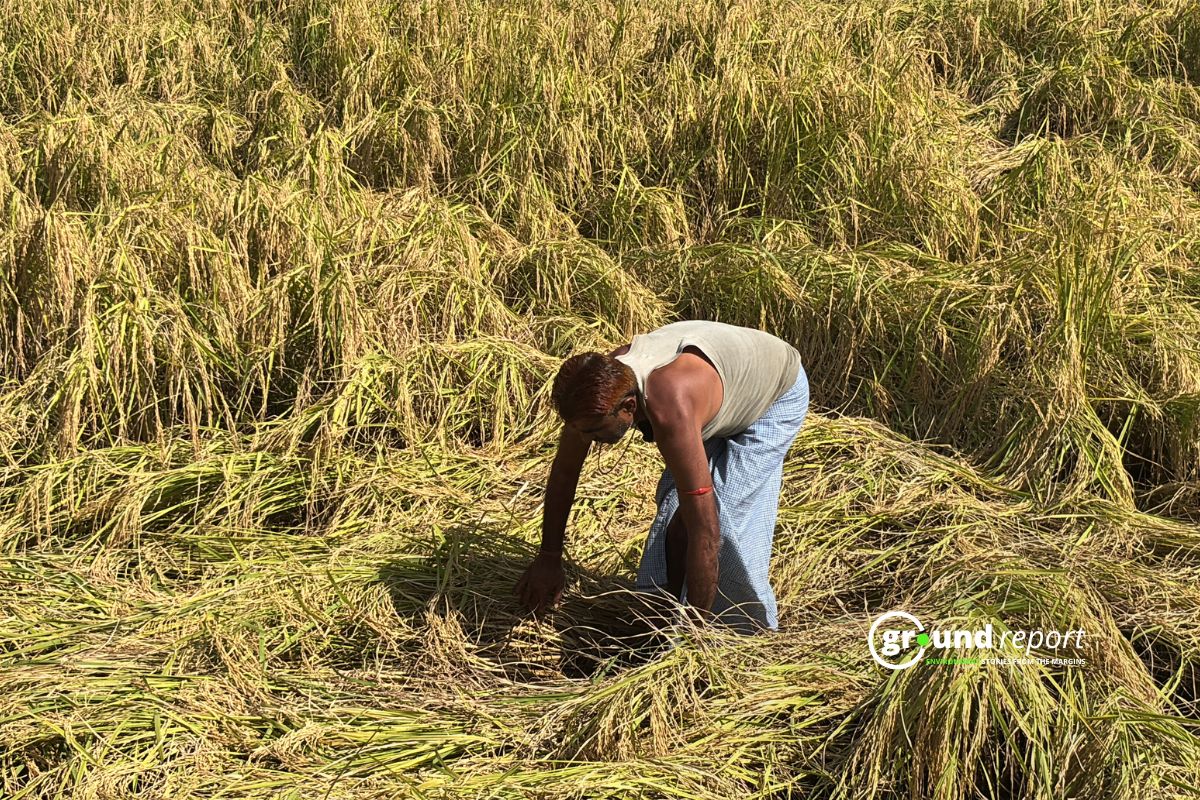On the afternoon of June 14, Kalpana Singh, 55, was clearing her field to plant paddy in Jhandaha Tola, Sonwari village, in Madhya Pradesh’s Maihar district. The sky was overcast—though there was no rain, flashes of lightning lit up the sky repeatedly. Suddenly, a lightning bolt struck her. Nearby villagers, who were also working in the fields, saw it happening.
A local villager contacted her brother, Nagendra Singh Patel, who lives 4 km away, to inform him of the incident. She was later rushed to the nearby Maihar Civil Hospital.
“She screamed in pain all night,” Nagendra told Ground Report. “Her hands and shoulders were the worst affected.”
When her condition didn’t improve overnight, he took her to the district hospital in Rewa, 70 km away. She is still undergoing treatment.
Kalpana is not alone.
Mantu Upadhyay, sarpanch of Sonwari—the largest village panchayat in Maihar—said three others were struck by lightning that same day.
“Mahajan Kol and Mohit Kol, from the tribal community, were also injured. One person died in Madhai village,” he said.
Lightning strikes kill across districts
In just 48 hours, lightning killed around 15 people across multiple districts. Dozens of livestock also died. In most cases, victims were outdoors, either working in the fields, walking, or taking shelter under trees.
The monsoon entered Madhya Pradesh on Monday via Barwani, Khargone, Khandwa, and Burhanpur. Rain was recorded in 14 districts. The monsoon is expected to reach Bhopal and Indore within two days and cover the entire state by June 25. Lightning is a recurring phenomenon during the rainy months in the state.
Over the past six years, Madhya Pradesh has recorded an average of 442 lightning deaths per year. One major reason for the high number of deaths is the state’s dense population. With 236 people per square kilometre, more people are exposed during lightning events. Though flat areas usually see fewer lightning strikes than hilly regions, the risk to human life remains high due to this exposure.
Dr. Sunita Verma, Associate Professor at the Institute of Environment and Sustainable Development at Banaras Hindu University and author of “The major lightning regions and associated casualties over India,” explains the core issue,
“The high casualties in Madhya Pradesh are due to the lack of an effective early warning system and unsafe sheltering practices among the rural populace, particularly farmers. Most fatalities occur when individuals seek refuge under trees during thunderstorms, not realizing the increased risk.”
Kalpana’s brother, Negendra, remembered two people who died in his village three years ago. When asked if he receives weather alerts on his phone, he shook his head. “We don’t get TV on mobile phones,” he said. “Sometimes newspapers mention it.” He paused and then added, “But even if I knew, what would I do? If there is farm work, then I have to do it.”
The man from Jhandaha Tola explained that they work even if it’s drizzling, stopping only when the rain becomes too heavy. “If we sit at home in fear of lightning”, he said, “we will be late in sowing.”
Climate Crisis Sparks More Lightning
Dr. Verma explains, “Madhya Pradesh experiences significant cumulonimbus cloud formation, prone to lightning activity… The government needs robust mitigation strategies, including timely warnings and accessible educational campaigns, especially in rural and vulnerable areas.”
Climate change is also making things worse. A study in the US found that every 1°C rise in global temperature can lead to a 12% increase in lightning. If the temperature rises by 4°C by 2100, lightning strikes could increase by 50%. Madhya Pradesh recorded nearly 1 million lightning strikes in 2022–23. That number is expected to go up.
Manoranjan Mishra, a Geography Professor at Fakir Mohan University and a lightning expert, links the rise in lightning activity to both natural and human factors.
“The central part of India is more vulnerable to lightning hazards,” said Mishra. “This is due to extensive mining, high population exposure, and rising heat combined with pre-monsoon moisture.”
He added, “A small increase in maximum temperature can add significant moisture to the atmosphere, making it thermodynamically unstable and leading to more lightning events.”
Madhya Pradesh isn’t just battling lightning. The state recorded 185 extreme weather days in 2024, the highest in India. That year, 353 people died due to storms, floods, and lightning. The toll has been rising. Since 2018, the state has averaged 266 weather-related deaths annually. In 2019 alone, floods killed 674 people and caused damage worth Rs 12,000 crore.
Rising temperatures create more unstable air and moisture, leading to stronger thunderstorms. These storms generate more lightning. More heat in the atmosphere means more energy for storm clouds, making them more violent and dangerous.
Pollution also plays a role. Aerosol pollution increases lightning activity. Urban areas with high pollution levels see more lightning. As pollution rises in Madhya Pradesh, this could worsen the problem. A 37% rise in lightning across India has been linked to pollution.
Despite the growing threat, lightning is still not treated as a disaster at the national level. In February 2024, Biju Janata Dal (BJD) MP Manas Ranjan Mangaraj asked the Central Government to declare lightning a natural disaster. The government refused, saying deaths can be prevented with awareness. States like Bihar, Madhya Pradesh, and West Bengal want lightning deaths to qualify for compensation from the State Disaster Response Fund.
Lightning Kills, But Still Not a Disaster
Mishra called for lightning to be declared a national disaster. “We need district-level vulnerability maps, updated building codes, and low-cost lightning protection systems in rural homes,” he said.
“Without targeted awareness and real infrastructure changes, zero lightning deaths will remain a distant goal.”
The Centre has acknowledged the rising threat from natural disasters. On June 16, Home Minister Amit Shah asked all states and union territories to prepare district-level disaster management plans within 90 days. He also called for state-level action plans against lightning and thunderstorms.
“Unless there is a district disaster management plan, it is not possible to fight disaster management with speed,” Shah said at a national conference of Relief Commissioners.
He urged states to share their lightning and heatwave plans with the Centre, and announced annual inter-state mock drills for cyclones and other disasters.
Shah also inaugurated a new Integrated Control Room for Emergency Response, built with ISRO’s technical support, to enable faster response and real-time monitoring during disasters.
Experts have suggested low-cost solutions. Chandima Gomes, a professor from South Africa, recommends using cargo containers as safe shelters. Public education campaigns, like the one in the US using the slogan “When Thunder Roars, Go Indoors,” have helped reduce deaths in other countries.
Ground Report previously reported on the impact of lightning strikes in Jammu & Kashmir, Odisha, Uttar Pradesh and West Bengal, highlighting the administration’s inaction.
Lightning remains a major threat in Madhya Pradesh. The state faces serious risks from climate change, rising pollution, and lack of strong policy response. The next few years will be key in deciding whether the state can reduce these avoidable deaths.
Support us to keep independent environmental journalism alive in India.
Keep Reading
How Can Bhoj Wetland Address the Issue of Microplastics?
Indore’s Ramsar site Sirpur has an STP constructed almost on the lake
Indore Reviving Historic Lakes to Combat Water Crisis, Hurdles Remain
Indore’s residential society saves Rs 5 lakh a month, through rainwater harvesting
Stay connected with Ground Report for under-reported environmental stories.
Follow us on X, Instagram, and Facebook; share your thoughts at greport2018@gmail.com; subscribe to our weekly newsletter for deep dives from the margins; join our WhatsApp community for real-time updates; and catch our video reports on YouTube.
Your support amplifies voices too often overlooked—thank you for being part of the movement.






